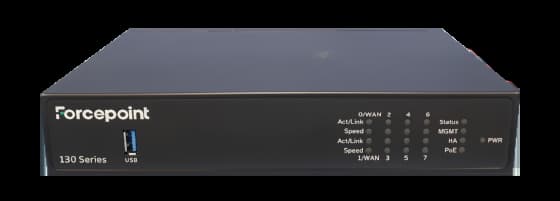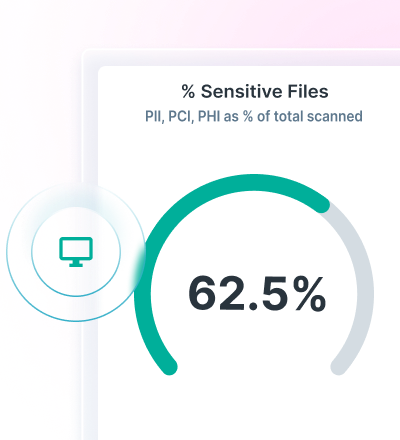
أكثر من 12 آلاف عميل يثبتون صحة اختيارنا










































وسّع نطاق الوصول إلى الشبكة وقم بتأمينه في المكاتب والفروع والمواقع البعيدة.
الاتصال الشبكي على مساحة واسعة نحو الأمان. تحمي خدمة Forcepoint Secure SD-WAN الشبكة من التهديدات المتقدمة من خلال عناصر تحكم في الأمان قائمة على مبدأ انعدام الثقة، Zero Trust، مع الحفاظ على اتصال متميز في أي مكان في العالم.
لماذا Forcepoint Secure SD-WAN؟
مركزية الإدارة: يمكن تفعيل الفروع والمكاتب والمواقع البعيدة من السحابة. ويمكن تكوين السياسات مرة واحدة واستخدام النشر بدون لمس من خلال وحدة التحكم في الإدارة الآمنة (SMC).
تحسين أداء التطبيقات: تقليل زمن الاستجابة والتغيير فيه وضمان حصول التطبيقات المهمة على أولوية عرض النطاق الترددي من خلال اتصال Multi-Link والتوجيه الديناميكي لحركة نقل البيانات ومراقبة سلامة التطبيقات وغيرها من الميزات.
الحماية من التهديدات المتقدمة: رصد المخاطر ومنعها باستخدام الفحص متعدد الطبقات ومنع التسلل وعقد بالوعة DNS وغير ذلك الكثير، مع تأمين الوصول إلى التطبيقات في الموقع أو عن بُعد من خلال ZTNA Application Connector.
تقليل تكاليف التشغيل: تمكن من خفض تكاليف الشبكات وتحسين الموثوقية من خلال المزج والمطابقة بين النطاق العريض المحلي لمزود خدمة الإنترنت واختيار MPLS الخاص في الوقت الفعلي.
ورقة البيانات
مقارنة نماذج الأجهزة


Global Network
20+
Countries
45+
Cluster Nodes
Clustering In a Way No One Else Can Do
Christian Keller, CISO at Huber + Suhner, lists reliability, clustering, and ability to navigate global compliance requirements among the top benefits of Forcepoint NGFW.
استكشاف نماذج Forcepoint Secure SD-WAN

السلسلة 3500
مثالية للمؤسسات الكبيرة وشبكات الحرم الجامعي ومراكز البيانات.
ما يصل إلى 66 واجهة
إنتاجية جدار الحماية تصل إلى 600 جيجابت في الثانية
إنتاجية IPS NGFW تصل إلى 140 جيجابت في الثانية

السلسلة 3400
مثالية لشبكات الحرم الجامعي ومراكز البيانات.
ما يصل إلى 67 واجهة
إنتاجية جدار الحماية تصل إلى 200-300 جيجابت في الثانية،
إنتاجية IPS NGFW تصل إلى 15-35 جيجابت في الثانية

السلسلة 2200
مثالية للمكاتب المتوسطة والكبيرة الحجم.
ما يصل إلى 25 واجهة
إنتاجية جدار الحماية تصل إلى 120 جيجابت في الثانية
إنتاجية IPS NGFW تصل إلى 13.5 جيجابت في الثانية

السلسلة 1200
مثالية للمكاتب متوسطة الحجم والكبيرة.
ما يصل إلى 17 واجهة
إنتاجية جدار الحماية تصل إلى 65 جيجابت في الثانية
إنتاجية IPS NGFW تصل إلى 5 جيجابت في الثانية

السلسلة 350
مثالية لمكاتب الفروع والمكاتب البعيدة (تصميم سطح المكتب).
ما يصل إلى 13 واجهة
إنتاجية جدار الحماية 40 جيجابت في الثانية
إنتاجية IPS NGFW تصل إلى 2 جيجابت في الثانية (N352) أو 4.1 جيجابت في الثانية (N355)

130 السلسلة
Ideal for remote offices, branches and stores.
ما يصل إلى 8 واجهة
إنتاجية جدار الحماية تصل إلى 8 جيجابت في الثانية
إنتاجية IPS NGFW تبلغ 1600 ميجابت في الثانية

السلسلة 120
مثالية للمواقع ومكاتب الفروع الفعلية.
ما يصل إلى 8 واجهات
إنتاجية جدار الحماية تبلغ 4 جيجابت في الثانية
إنتاجية IPS NGFW تبلغ 450 ميجابت في الثانية

السلسلة 60
مثالية للمكاتب والفروع عن بُعد والمواقع الفعلية.
ما يصل إلى 4 واجات
إنتاجية جدار الحماية 2 جيجابت في الثانية
إنتاجية IPS NGFW تبلغ 350 ميجابت في الثانية
صور الخدمة السحابية:
- برنامج Forcepoint NGFW الموحد
- (AWS) Amazon خدمات الويب من
- Microsoft Azure حلول
- تأمين الاتصالات بين الشمال والجنوب داخل / خارج الخدمة السحابية وحركة مرور SDN من الشرق إلى الغرب
الأجهزة الافتراضية:
- برنامج Forcepoint NGFW الموحد
- متاح لخدمات KVM وVMware ESXi وNSX
- يُعدل لقبول 64 وحدة معالجة مركزية
- أتمتة التقسيم الجزئي للشبكة
- يمكن التنظيم مع جدران الحماية الفعلية


دليل المشتري لـ Secure SD-WAN
سواء كنت تشتري لأول مرة أو تفكر في الترقية، فإن دليلنا يحتوي على المعايير الرئيسية لتقييم حلول Secure SD-WAN. اكتشف الاعتبارات الخمسة الرئيسية التي يجب أن تأخذها في الاعتبار.
لماذا يختار العملاء SD-WAN
لماذا يختار العملاء SD-WAN
"Our costs - both for the project and maintenance - are going down because we don't need resources locally, we have centralized everything. If we want new service on a train, we define the policy then give the hardware to the operator, who installs it."
VR Group
Frequently Asked Questions
What is managed SD-WAN?
A managed SD-WAN is a service where a provider handles the deployment, configuration, monitoring and optimisation of your WAN. Meanwhile, a cloud-managed SD-WAN adds centralised control via the cloud, making it easier to apply consistent policies, improve performance and maintain security across distributed networks without internal resource strain. Learn more about this product through our comprehensive managed SD-WAN solutions guide.
What are the benefits of SD-WAN?
Benefits of Forcepoint Secure SD-WAN include the following:
Centralized management
Improved application performance
Protection against advanced threats
Reduced operating costs
How much does SD-WAN cost?
SD-WAN costs are determined by factors, including the type of deployment, the size of the network, the number of locations to connect, the type and amount of data transiting the network and any existing infrastructure that may be leveraged when deploying an SD-WAN solution.
What is SD-WAN security?
SD-WAN security helps organizations enable effortless connection to cloud resources while protecting users, data and IT environments from attack.
What is an SD-WAN solution?
Ad SD-WAN solution applies software-defined networking principles to the wide area network.
What is an SD-WAN provider?
SD-WAN providers enable organizations to deploy SD-WAN technology.
What is an SD-WAN appliance?
SD-WAN appliances are physical or virtual controllers located on-premises or in the cloud that connect an organization’s users to applications, services and workloads.
How do SD-WAN appliances work?
SD-WAN appliances and products are designed to overcome the challenges of ensuring fast and secure connectivity for branch locations and hybrid workforces. The traditional wide area network uses a hub-and-spoke model that requires all traffic to flow through a central data center. For organizations with a highly distributed workforce, this model adds unacceptable levels of latency that negatively affect user experiences and productivity. Additionally, legacy WANs are built with costly Multiprotocol Label Switching (MPLS) connections that are time-consuming to manage and deploy, preventing organizations from scaling easily and cost-efficiently. SD-WAN overcomes these issues by creating a virtual overlay for the network that abstracts network connections and enables the use of additional, low-cost transport services that add redundancy and flexibility.
What is Multiprotocol Label Switching (MPLS)?
Multiprotocol Label Switching (MPLS) is data forwarding technology that increases the speed and controls the flow of network traffic.
What is SD-WAN vs MPLS?
SD-WAN is a networking technology that uses software to make wide area networks more intelligent and flexible by connecting sites directly to the internet over commodity broadband links. Configurations and access policies are centrally managed and easily applied across all sites, removing the need to manual administer each WAN device individually. MPLS is data forwarding technology for network traffic that directs data through a path via labels instead of requiring complex lookups in a routing table at every stop. Traditional networking technology, MPLS, has seen competition from SD-WAN solutions to meet today's high demands and expanding needs for networked business-critical systems.










